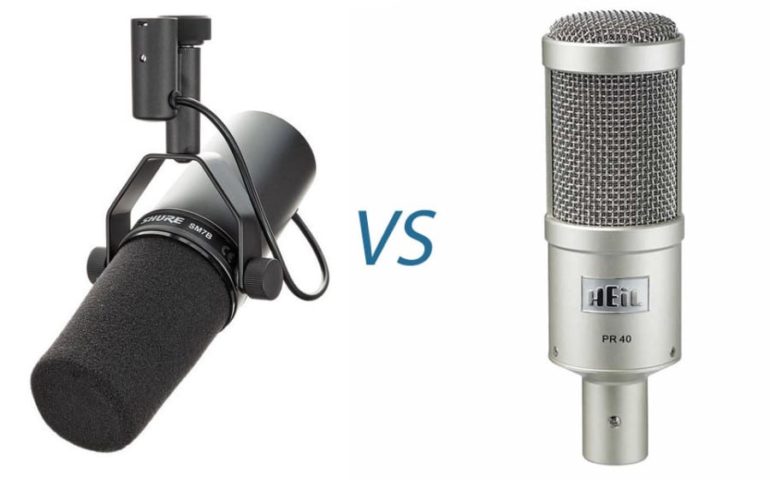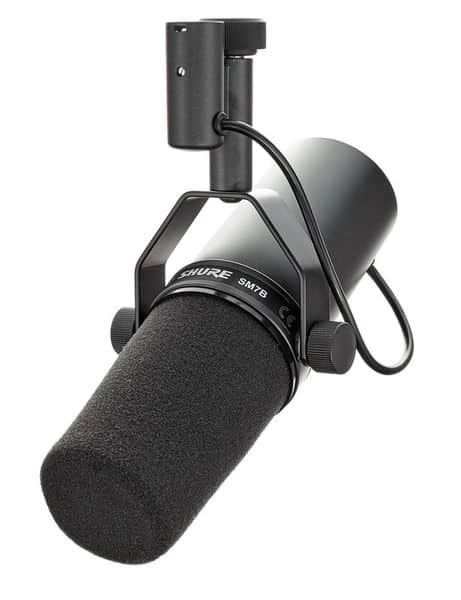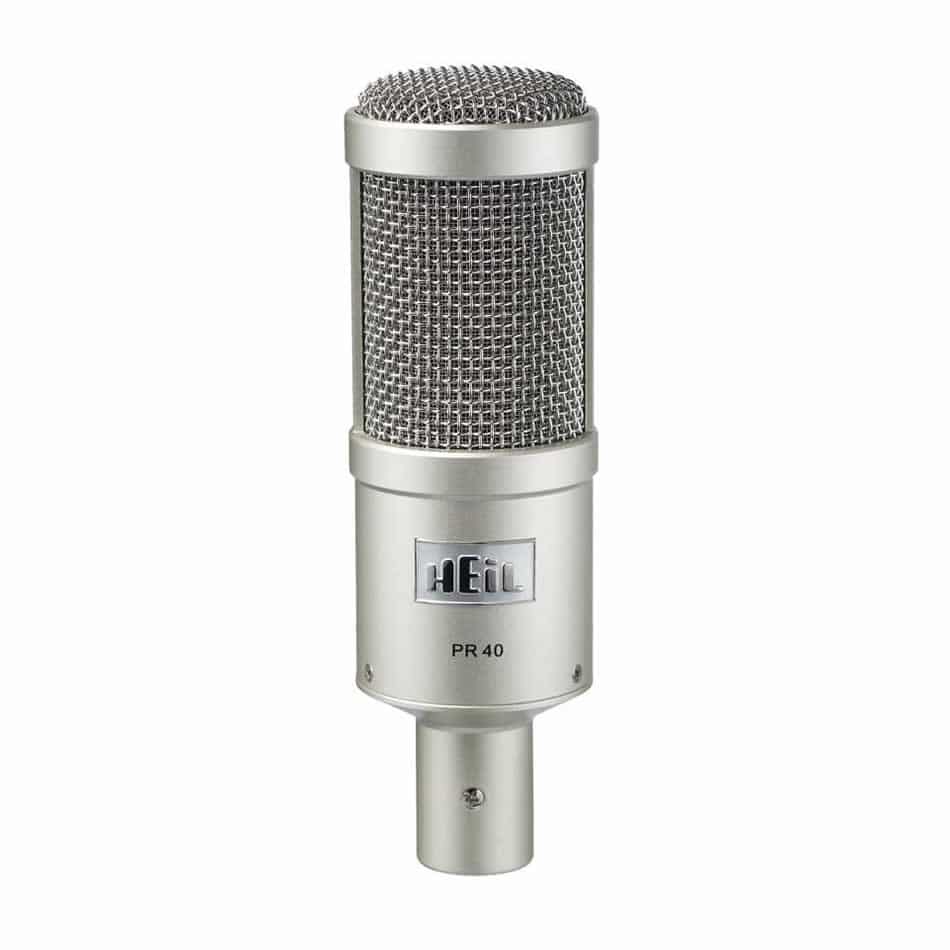Last updated on December 30th, 2023 at 02:54 pm
I consider both of these microphones, the Heil PR40 and the Shure SM7B, to be one of the best dynamic microphones available today.
They work great both for recording podcasts and also music. Some even use them during live performances.
Both go for about the same price, with the Shure SM7B being about $50 dollars more expensive.
Let’s kick things off with the Shure SM7B, shall we?
Shure SM7B
The Shure SM7B cardioid dynamic microphone has been around quite some time now, and for good reason.
You may have heard that Michael Jackson used an SM7, which was practically the same mic ( the difference is that the SM7B has a Hambucking coil inside the mic and a larger windscreen), to record “thriller”, “Off the Wall” and “Bad”.
Other artists that also use the SM7B are The Red Hot Chili Peppers, Willie Nelson, Metallica, and many more. So it should come as no surprise that this microphone is of superb quality.
Since it has a 50Hz – 20kHz flat frequency response, it not only excels at recording music and vocals but it has also got a huge variety of applications, such as voice-over and pod-casting.
One important thing you should know, if you’re considering of buying one of these is that it’s a very low output microphone.
It needs a powerful preamp to boost the signal, you would need a good Audio Interface or you could buy something like the Cloudlifter CL-1, which adds up to 25db to the signal, without affecting the characteristics of the sound one bit.
So, if you don`t have a good preamp then you will need one of these and they are quite pricey.
The Cloudlifter CL-1 needs the phantom power of your interface to be turned on. It takes that power and drives it into the dynamic mic to boost its signal.
So, there are some pros and cons to this mic;
Pros
- Very Versatile.
- Natural, warm and smooth sounding.
- Minimal EQ needed.
- Very Quiet.
- Good for live recording.
- Very Durable.
- Comes with built in shock-mount.
- Hard to get a plosive when using it.
- Improved rejection of electromagnetic hum.
- Internal air suspension shock isolation.
- Bass roll-off and mid-range boost (called presence)
Cons
- A bit dark and muddy on lower registers.
- Low Output (if your preamps isn’t great and you turn the gain up, it may add a lot of noise).
Since it’s got low output you might need a microphone preamp.
As we have already established, this is a great mic! Especially considering that so many well-known artists have used them!
I mean, hey! If it’s good enough for Michael Jackson, it sure as hell is good enough for me! You would never go wrong with this one since it`s so versatile!
The Shure SM7B is able to withstand almost anything (up to 180db SPL, which is way more than a Human ear can handle), which means that it can be used to record any instrument without fear of ever getting damaged, plus it’s incredibly balanced and never distorts the sound, no matter the volume.
Now let’s get into the specifics a bit:
Features
- Flat, wide-range frequency response for exceptionally clean and natural reproduction of both music and speech
- Bass rolloff and mid-range emphasis (presence boost) controls with graphic display of response setting
- Improved rejection of electromagnetic hum, optimized for shielding against broadband interference emitted by computer monitors
- Internal “air suspension” shock isolation virtually eliminates mechanical noise transmission
- Highly effective pop filter eliminates need for any add-on protection against explosive breath sounds, even for close-up vocals or narration
- Now shipping with the A7WS detachable windscreen, designed to reduce plosive sounds and gives a warmer tone for close-talk vocals
- Yoke mounting with captive stand nut for easy mounting and dismounting provides precise control of microphone position
- Classic cardioid polar pattern, uniform with frequency and symmetrical about axis, to provide maximum rejection and minimum coloration of off-axis sound
- Rugged construction and excellent cartridge protection for outstanding reliability
- Replacement cartridge: RPM106
Would I recommend this microphone? Well of course, it’s one of those “you can’t really go wrong with it” situations.
The only issue it its price range plus the need for a really good preamp, which when combined, will cost you quite a lot, unless you already have a great Audio Interface or Mixer with good preamps.
You could use a not so expensive Audio Interface like the Focusrite Scarlett 2i2 (2nd Gen), BUT you will have to drive the gain almost up to 100%. It can work, but if you want more control over the gain, get the Cloudlifter CL-1.
Depending on your needs you could get other really good microphones for much less. It all depends on the use you want to give it.
For instance if you’re recording something like vocals only you could go with the AKG C214 or the Rode NT1A, both great condenser mics.
Another option would be the great Shure SM58 , which is known to be the go-to dynamic mic, being extremely versatile, great sounding and costing only ¼ of what the SM7B does.
Still, I don’t think you could ever go wrong with it. It’s a fantastic piece of Equipment.
Check prices for the Shure SM7B Here:
- Shure SM7B: Amazon, Sweetwater.
Heil PR40
Just like with the Shure SM7B, the Heil PR40 is considered to be one of the best dynamic microphones out there.
It is great for recording Vocals, kick- and snare-drums and electric instruments, cabinets and it is also great for live performances.
But it’s actually known for excelling at pod-casting and voice-over, it’s considered to be the “Holy Grail” for those applications.
At first glance it looks like a typical condenser microphone but it’s actually a really high-quality dynamic mic!
What makes this mic so great? Well since it’s a dynamic microphone and not a condenser, it’s actually very forgiving with ambient noise.
Let’s say you are pod-casting and there is some outside noise, with this microphone you won’t pick up as much of the noise as with a condenser mic.
But don’t be fooled, even though condenser microphones are a bit more sensitive, this is a great dynamic mic! The recording quality you can get out of it is top notch.
As stated above, even though this microphone is famous in the pod-casting world, it is still a good choice for music recording and for live performances! You can get good results recording Guitar and Bass cabinets. I wouldn’t really use it that much for recording an acoustic Guitar.
Just as with the Shure SM7B, you will need a good preamp to drive this microphone, it doesn’t require exactly as much power though. But again, if your interface lacks the power you can always invest in the Cloudlifter CL-1.
Pros
- Really nice noise rejection.
- Great broadcast tone for podcasting.
- All metal body, it`s build like a tank! Very durable.
- Really clear and open top-end.
- Extended low frequency response.
- Bright like a condenser but great for ignoring ambient noise.
Cons
- No extra switches like on the Shure SM7B.
- No gain control.
Here are the specifics of the mic.
Features
- Metal grill plus another second and finer foam windscreen inside to help with the plosives (Still you might want to get a regular windscreen).
- 3 pin XLR Output.
- Cardioid pattern.
- Frequency response: 28hz – 18khz
- Output Level: -53.9dB.
- Impedance: 600 ohms balanced.
What do you get when you buy it?
- The microphone.
- Leather carrying case.
- Microphone mount.
- And some documentation.
You can also buy the Heil PR40 microphone bundle, where you get a couple of extra stuff which I actually recommend since unless you already have a shock mount and a boom arm, you will have to get some anyway!
- In this bundle you also get the Heil PL2T Boom arm, which will allow you to move it around really easy!
- You also get the PRSM Shock Mount, which holds the microphone in place and helps avoid any unwanted mechanical noise.
- Lastly you also get an XLR cable.
With this mic you CAN go with an Audio Interface like the the Focusrite Scarlett 2i2 (2nd Gen) without the Cloudlifter CL-1.
In this case you get a good signal at about 70% gain which is fine. Still, if you would like to have more control over the amount of gain you drive to the mic, you could invest in the Cloudlifter CL-1.
Check prices for the Heil PR40 Here:
- Heil PR40: Amazon.
Similarities
- Both of these microphones actually benefit from the Cloudlifter CL-1 since they have low output.
- They do really well with flat EQ settings.
- Great at rejecting ambient noise really well!
Differences
Shure SM7B:
- More Versatile, better for recording music over all.
- A bit warmer sounding.
- Low end not as great, a bit more muddy.
- Bass roll-off and presence boost.
- Comes with two windscreens.
Heil PR40:
- Best suited for voice-over and pod-casting. (Still usable for music recording).
- Sounds a bit more flat.
- Retains the lower registers a lot better.
- Doesn’t come with a windscreen.
- No additional features like the Bass roll-off.
In conclusion
Both microphones are vert similar and you can’t really say that one is better than the other. For the price range you KNOW that both of them are going to perform great.
It all comes down to personal taste and budget options. Personally I would chose the SM7B because it’s more versatile, even though it requires a better preamp!
Also make sure to read this huge post I wrote about the 16 best microphones under $300 if neither the SM7B or the PR40 are exactly what you need.
I really hope this was useful to you! See you on the next one!



Grazie per la recensione. Ho appena ordinato un Rode nt1a per home recording. Non ho esigenze importanti e mi serve per registrare qualche canzone da casa. Spero di aver acquistato un buon microfono. Mi viene il dubbio che forse era migliore Nt1? ci sono grandi differenze?